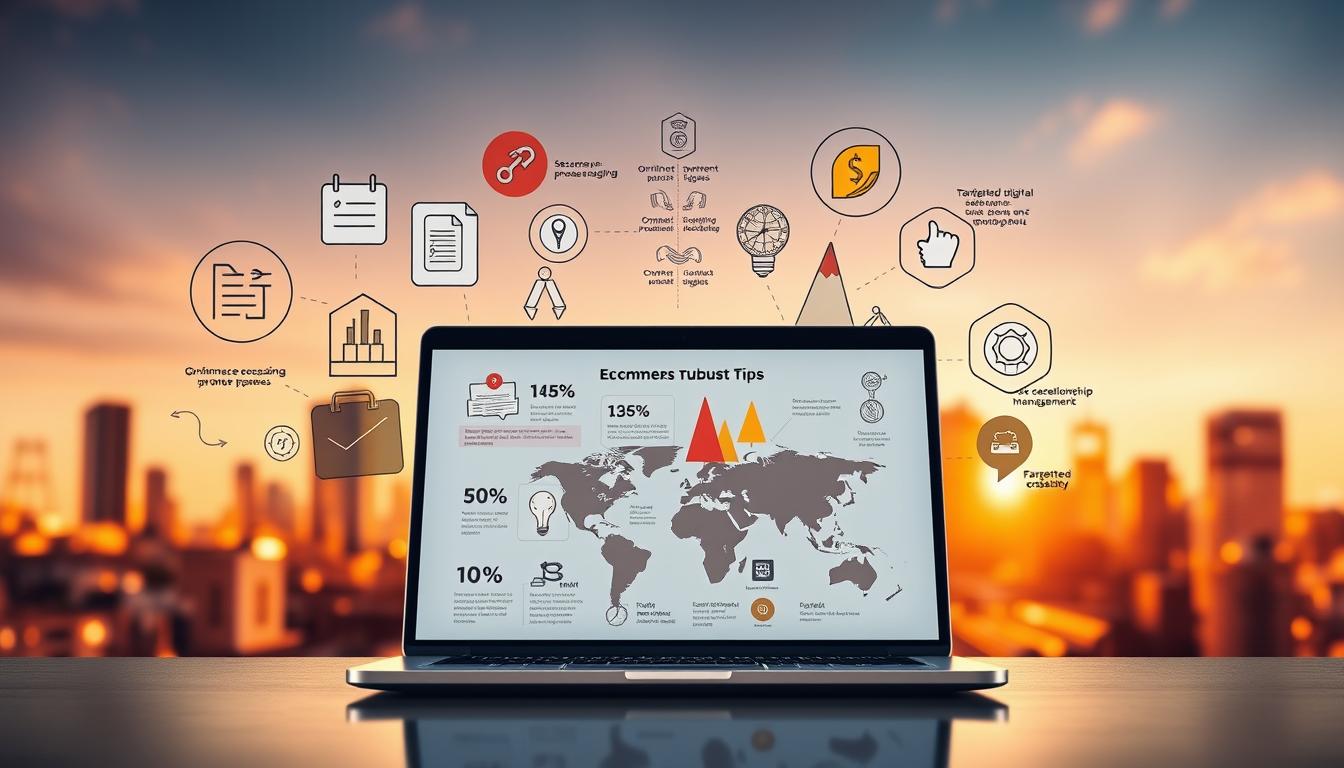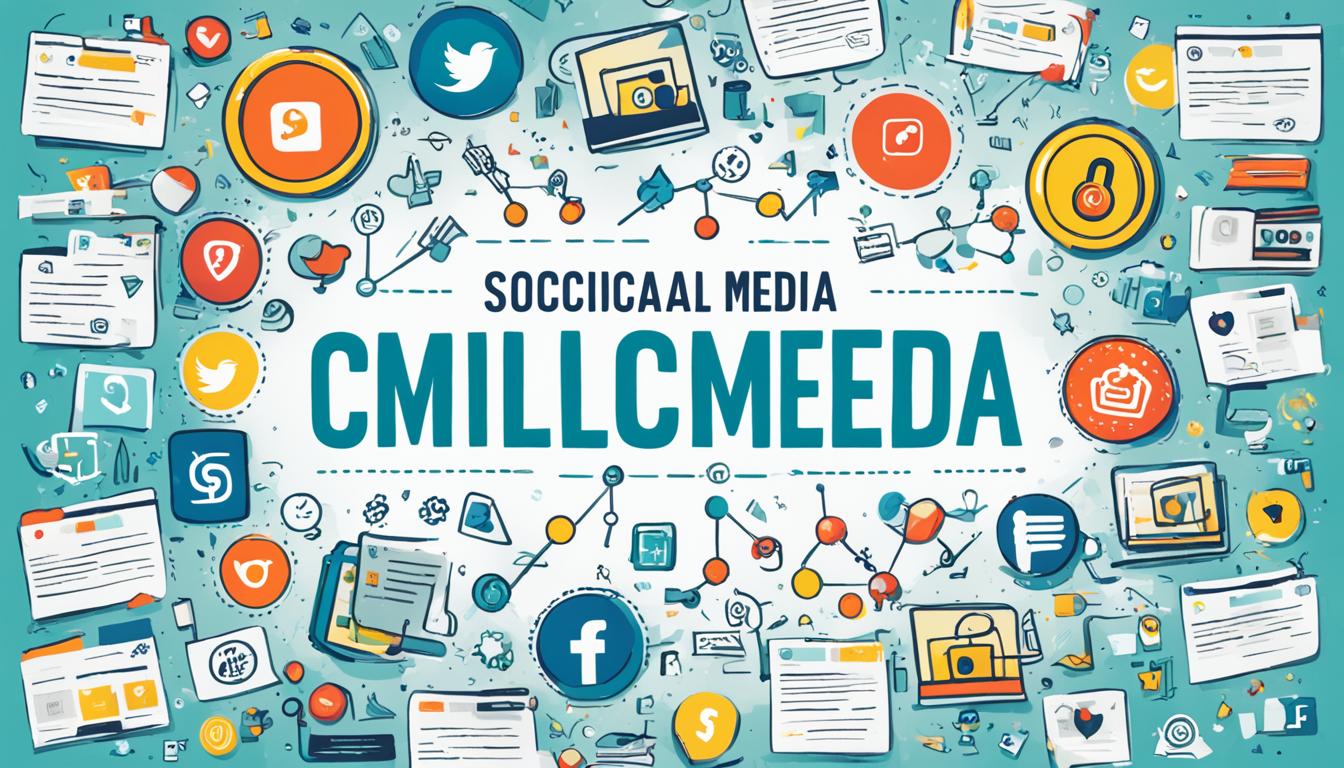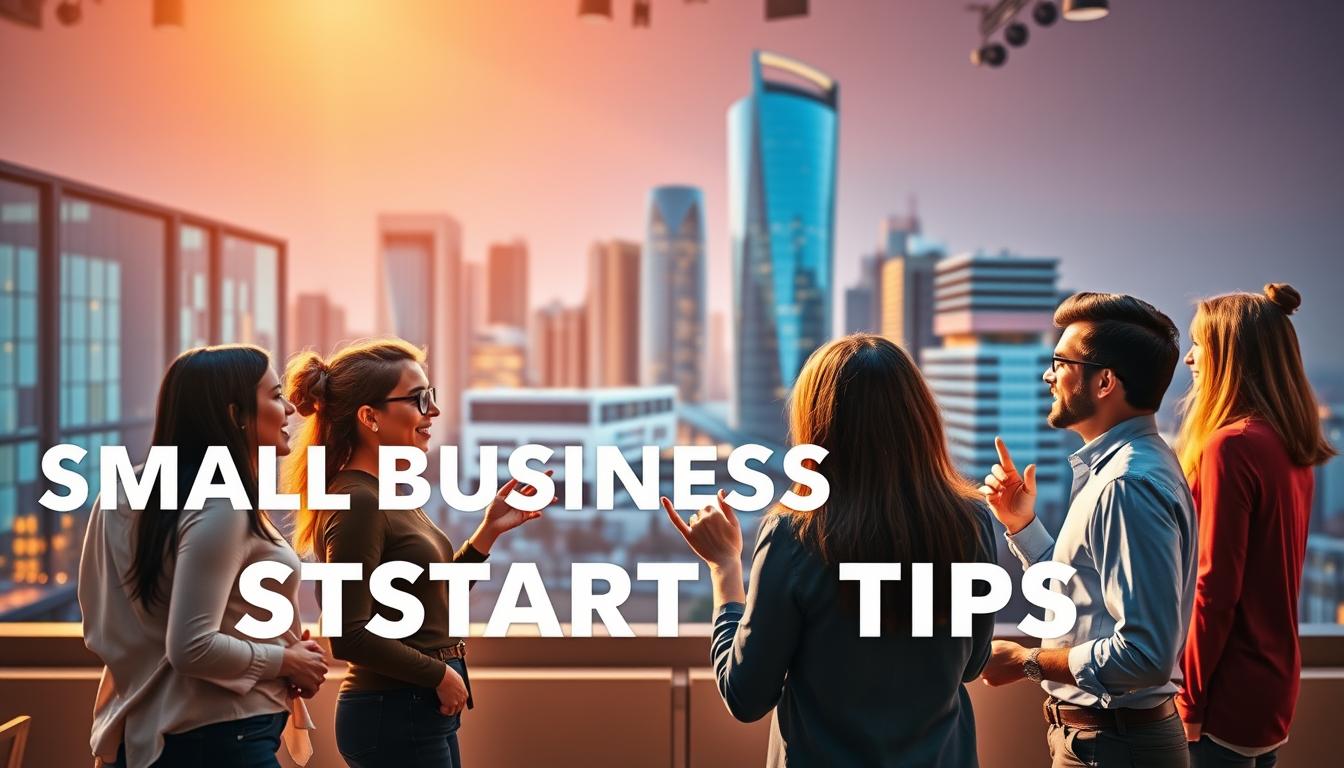Did you know that the global ecommerce market is projected to reach a staggering $6 trillion by 20241? This massive opportunity is both exciting and challenging, especially in today’s highly competitive landscape. To stand out, strategic planning and a unique value proposition are essential.
In saturated markets, differentiation is key. Understanding your niche and optimizing user experience (UX) can make or break your success2. That’s where tools like digital libraries come in. They offer e-books, courses, and free webinars to help you implement these strategies effectively.
From developing a strong USP to mastering retention tactics, every step matters. My journey in navigating these challenges has taught me the importance of staying adaptable and informed. Let’s explore how you can launch your online store with confidence.
Key Takeaways
- The global ecommerce market is projected to hit $6 trillion by 20241.
- Strategic planning and differentiation are crucial in competitive markets2.
- Digital resources like e-books and webinars can enhance your strategy.
- Focus on USP development, UX optimization, and retention tactics.
- First-person experience offers practical insights into modern challenges.
Why Ecommerce Business Tips Matter in 2024
The $6 trillion market presents both challenges and opportunities. With such a massive potential, understanding consumer behavior and market trends is crucial. Let’s dive into what makes this landscape so competitive and how you can thrive.
The $6 Trillion Opportunity You Can’t Ignore
By 2024, the global market is projected to hit $6 trillion3. This growth is driven by evolving consumer expectations and technological advancements. For instance, 82% of shoppers prioritize free shipping, making it a key factor in their purchasing decisions3.
To capitalize on this opportunity, focus on delivering value. Tools like live chat can reduce cart abandonment by 77%, enhancing the customer experience. Additionally, adopting a mobile-first approach ensures your site loads within the critical 50ms first impression window.
How Competition Shapes Modern Online Stores
Competition is fiercer than ever, with brands like ModCloth using urgency timers to create a sense of scarcity. This strategy encourages quick purchases and boosts conversions. Analyzing competitors through frameworks like SWOT can help you identify strengths and weaknesses3.
Here are some key strategies to stay ahead:
- Speed vs. Personalization: Balance fast loading times with tailored experiences.
- Mobile Optimization: Use tools like Google’s mobile-friendly test to ensure your site performs well on all devices.
- Consumer Expectations: Meet demands like free shipping and seamless navigation.
For more insights on building a successful online store, explore this resource.
Start Strong with a Unique Selling Proposition
Standing out in a crowded market starts with a clear and compelling USP. Your unique selling proposition is what sets you apart and makes your brand unforgettable. It’s not just about what you sell—it’s about why customers should choose you over competitors.
How to Identify Your Niche
Understanding your niche is the first step to crafting a strong USP. Look at brands like Warby Parker and Dollar Shave Club. They identified gaps in the market and built their success around solving specific customer pain points4.
To find your niche, ask yourself: What problems can I solve? Who is my ideal customer? What makes my approach unique? Answering these questions will help you carve out a space where your brand can thrive.
Crafting a Plan That Stands Out
A solid plan is essential for turning your USP into reality. Take inspiration from MrBeast, who built his YouTube empire by focusing on a clear vision and strategic execution5. Your plan should include:
- Financial Planning: Aim for an 18-24 month runway to ensure stability5.
- Lean vs. Traditional Models: Choose a template that fits your goals and resources.
- Real-World Examples: Learn from Peppermint Products, which excelled by positioning itself in a specific niche.
Promote your USP across all touchpoints—your website, emails, social media, and even in-store banners. This consistency builds brand stickiness and makes your business hard to imitate5.
“Your USP is not just a tagline—it’s the heartbeat of your brand.”
For a step-by-step guide, download our checklist with KPIs to ensure your plan is on track.
Optimize Your Website’s User Experience
Your website’s user experience can make or break your success in today’s digital landscape. With 73% of shoppers using multiple devices, ensuring your site is fast, intuitive, and mobile-friendly is critical6. A seamless experience keeps customers engaged and drives conversions.
Why 0.5 Seconds Decides Your Fate
Speed is everything. A website that loads in under 1 second has a 3x better conversion rate than one that takes 5 seconds7. Even a half-second delay can frustrate users and lead to abandoned carts. Tools like Google’s mobile-friendly test can help you identify and fix performance issues8.
Essential Design Elements for Conversions
Design plays a huge role in user satisfaction. A sticky navigation bar ensures key information is always accessible, while clean layouts with clear CTAs guide visitors effortlessly7. SSL certificates also build trust by securing data, which search engines prioritize7.
Mobile-First: Non-Negotiable in 2024
With most traffic coming from mobile devices, a mobile-first approach is essential. AMP implementation for product pages and optimized checkout flows can significantly reduce abandonment rates8. Progressive Web Apps (PWAs) offer faster load times and a more engaging experience, making them a smart investment8.
“A well-optimized website isn’t just a tool—it’s a competitive advantage.”
For actionable steps, explore our mobile UX checklist in the digital library. These strategies will help you create a website that not only looks great but also performs flawlessly.
Master Email Marketing for Ecommerce Success
Email marketing remains a cornerstone of digital success, with its global value soaring to $8.6 billion9. It’s not just about sending emails—it’s about building relationships and driving meaningful engagement. To truly excel, you need to focus on strategies that resonate with your audience and deliver measurable results.

Building Your Subscriber List the Right Way
Growing a subscriber list is the foundation of effective email marketing. Start by offering incentives like discounts or exclusive content to encourage sign-ups. Clear CTAs and social proof, such as testimonials, can also boost conversions9.
Segmented campaigns are key. Tailor your emails based on customer behavior, preferences, and demographics. This approach ensures your messages feel personal and relevant, increasing the likelihood of engagement10.
Open Rates That Tell the Real Story
Understanding open rates is crucial. The average benchmark for ecommerce is 42%, but achieving this requires more than just catchy subject lines9. A/B testing can help you determine what works best—emotional triggers like urgency or rational appeals like value propositions.
Timing also matters. Optimize send times based on your audience’s behavior and time zones. Tools like email automation can streamline this process, ensuring your messages arrive at the right moment10.
“Email marketing isn’t just about sending messages—it’s about creating connections that drive action.”
Re-engagement campaigns are another powerful tool. Win-back emails, special offers, and personalized content can reignite interest among inactive subscribers10. By focusing on these strategies, you’ll not only improve open rates but also build lasting relationships with your customers.
Ready to take your email marketing to the next level? Join our live masterclass for actionable insights and expert guidance.
Build a High-Converting Ecommerce Funnel
Understanding your customers’ journey is the key to building a high-converting sales funnel. With a 68% cart abandonment rate industry average, optimizing each stage of the funnel is critical11. A well-structured process ensures visitors move smoothly from awareness to purchase.
Start with top-funnel strategies to capture attention. Use influencer partnerships and social media campaigns to spark interest12. Middle-funnel tactics like engaging videos and infographics educate potential customers and build trust12.
At the bottom of the funnel, focus on driving action. Exit-intent pop-ups and time-sensitive deals can recover abandoned carts and encourage decisions11. SMS integration is another powerful tool for cart recovery, offering real-time reminders to hesitant customers11.
Post-purchase engagement is just as important. Send personalized order confirmation emails and implement satisfaction surveys to foster loyalty12. Tools like Google Analytics and Hotjar help monitor behavior and refine the funnel for better results12.
“A well-optimized funnel isn’t just about sales—it’s about creating a seamless experience that keeps customers coming back.”
For a step-by-step guide, download our funnel mapping template with automation triggers. This resource will help you streamline your process and maximize conversions.
Leverage Social Media Platforms Strategically
Social media platforms have become essential tools for driving engagement and sales in today’s digital-first world. With Instagram and TikTok leading the charge, understanding where to focus your efforts can make a significant difference. Both platforms offer unique opportunities, but choosing the right one depends on your audience and goals.
Instagram vs. TikTok: Where to Focus
Instagram boasts 130 million U.S. users, primarily millennials, making it ideal for targeting that demographic13. Its swipe-up links and visual content features, like image carousels, can drive a 10x increase in click-through rates14. On the other hand, TikTok has over 1 billion global users, offering a massive reach, especially for younger audiences13.
Here’s a quick comparison to help you decide:
| Platform | Audience | Key Features | Best For |
|---|---|---|---|
| Millennials | Swipe-up links, image carousels | Visual storytelling, brand awareness | |
| TikTok | Gen Z | Short-form videos, viral challenges | Engagement, viral campaigns |
Content Calendars That Drive Sales
A well-planned content calendar is your secret weapon for consistent engagement. Seasonal themes, like back-to-school or holiday campaigns, can align with product drops for maximum impact14. Tools like Canva make batch content creation efficient, saving time while maintaining quality14.
Here’s a 6-step process to optimize your calendar:
- Plan seasonal content around key events.
- Coordinate product launches with content themes.
- Use tools like Canva for batch creation.
- Analyze performance metrics to refine strategies.
- Engage with user-generated content for authenticity.
- Schedule posts using tools like Hootsuite for consistency13.
Analytics-driven optimization ensures your content resonates with your audience, driving meaningful results14. For deeper insights, access our 2024 Trend Prediction Report to stay ahead of the curve.
Ecommerce Business Tips for Customer Retention
Retaining customers is often more cost-effective than acquiring new ones, making it a critical focus for long-term success. With 82% of customers prioritizing free shipping, understanding its impact on retention is essential15. Loyalty programs and thoughtful shipping strategies can turn one-time buyers into lifelong advocates.
Loyalty Programs That Actually Work
Loyalty programs are more than just points systems—they’re about creating meaningful connections. Over 80% of customers are happy to share personal information if it ensures a more personalized experience, which can be leveraged in loyalty programs15. Programs that reward referrals, social media engagement, and personalized offers can significantly improve retention rates15.
Here’s how to make your loyalty program stand out:
- Personalized Rewards: Tailor rewards based on customer preferences and behavior.
- Exclusive Perks: Offer early access to sales or limited-edition products.
- Gamification: Use challenges or milestones to keep customers engaged.
The Psychology Behind Free Shipping
Free shipping isn’t just a perk—it’s a psychological trigger. Studies show that 82% of customers prioritize free shipping when making purchasing decisions15. It reduces friction in the buying process and creates a sense of value, even if the cost is absorbed elsewhere.
Here are some strategies to implement free shipping effectively:
| Strategy | Benefit |
|---|---|
| Minimum Order Threshold | Encourages larger purchases to qualify for free shipping. |
| Shipping Cost Absorption | Builds customer trust by eliminating hidden fees. |
| Returns Policy Integration | Simplifies the process, reducing hesitation to buy. |
| International Shipping Considerations | Expands your reach while maintaining customer satisfaction. |
“Free shipping isn’t just a cost—it’s an investment in customer loyalty.”
For deeper insights, use our Shipping Cost Calculator Spreadsheet to optimize your strategy. By focusing on loyalty programs and the psychology of free shipping, you can create a retention strategy that drives repeat sales and builds lasting relationships.
Streamline Operations with Third-Party Logistics
Efficient logistics can transform your operations and elevate customer satisfaction. Outsourcing to a 3PL provider eliminates the need for in-house warehouses and fulfillment teams, reducing costs and liability16. This shift allows you to focus on growth while experts handle the complexities of shipping and inventory management.
When should you transition from in-house to 3PL? If you’re struggling with scaling, managing peak seasons, or meeting delivery expectations, it’s time to consider outsourcing. A good 3PL provider offers services like inventory management, order tracking, and labeling to ensure seamless fulfillment16.
Integrating an inventory management system is crucial for accuracy and efficiency. Advanced tools like UCC 128 labeling and shipping notices ensure timely order fulfillment16. Multi-warehouse distribution networks further enhance delivery speed, improving customer satisfaction16.
Returns processing is another area where 3PLs excel. During peak seasons, handling returns can be overwhelming. Partnering with a provider that manages returns efficiently ensures customer needs are met without disrupting your operations16.
“Outsourcing logistics isn’t just a cost-saving move—it’s a strategic decision to scale smarter.”
Here’s how to choose the right 3PL partner:
- Experience: Look for providers with expertise in your industry and compatibility with platforms like Shopify or Amazon16.
- Flexibility: Ensure they can scale services to match your demand fluctuations16.
- Technology: Opt for providers offering advanced tools for inventory and order tracking16.
Ready to streamline your logistics? Download our 3PL Negotiation Checklist to make informed decisions and optimize your supply chain.
Turn Returns into Revenue Opportunities
Returns don’t have to be a loss—they can be a revenue driver. With the right strategies, you can turn this often-overlooked process into a profit center. For example, AfterShip’s data shows a 30% lift in repeat purchases when returns are handled effectively17.
One powerful approach is offering store credit instead of refunds. Platforms like Bigblue encourage repeat purchases by providing store credit, which keeps customers engaged18. Another strategy is implementing returnless refunds, where customers keep the item and still receive a refund. This reduces logistics costs and improves satisfaction.
Upselling during the returns process is another game-changer. Tools like Loop allow you to suggest alternative products, increasing sales while resolving customer issues18. AI optimization can also reduce return rates by up to 20%, as demonstrated by Returnalyze17.
Eco-friendly packaging is another way to attract environmentally conscious customers. Bigblue’s plastic-free options not only reduce waste but also enhance your brand’s reputation18. For more insights, explore these strategies to convert returns into revenue.
“A smart returns process isn’t just about resolving issues—it’s about creating opportunities to grow.”
By focusing on these strategies, you can transform returns into a powerful tool for boosting sales and building customer loyalty. Download our Returns Policy Template Bundle to get started today.
Live Chat: Your Secret Sales Weapon
Live chat is more than just a support tool—it’s a powerful sales driver. With 73% of customers reporting higher satisfaction compared to other support channels, it’s clear that live chat can significantly enhance the user experience. When implemented correctly, it not only resolves queries but also drives conversions and builds trust.
Balancing chatbots and human support is key. While chatbots handle routine inquiries efficiently, human agents excel at providing personalized interactions and recommendations. This combination ensures customers feel valued while streamlining operations19.
Proactive chat triggers can make a big difference. Engaging customers at critical points in their buying journey, such as when they’re about to abandon their cart, can increase conversion rates19. Optimizing sales scripts ensures every interaction is impactful, guiding customers toward a purchase.
Integrating live chat with CRM systems enhances the customer experience. It allows agents to access customer history, personalize interactions, and identify upsell opportunities20. This seamless integration ensures every chat is both efficient and effective.
“Live chat isn’t just about answering questions—it’s about creating opportunities to connect and convert.”
Here’s a quick look at live chat response time benchmarks:
| Response Time | Customer Satisfaction |
|---|---|
| Under 1 minute | 90% |
| 1-2 minutes | 75% |
| Over 2 minutes | 50% |
For deeper insights, explore our Live Chat Response Time Guide to optimize your strategy. By leveraging live chat effectively, you can turn every interaction into a sales opportunity and build lasting relationships with your customers.
Conclusion: Your Path to Ecommerce Success Starts Now
Launching your online venture is an exciting journey filled with opportunities. From crafting a strong unique selling proposition to mastering retention strategies, every step matters. Remember, success comes from continuous learning and adapting to the ever-changing digital landscape21.
Take action today. Implement the strategies you’ve learned, and don’t hesitate to iterate as you grow. For additional support, explore our digital library packed with e-books, courses, and free webinars. These resources are designed to elevate your skills and keep you ahead of the curve22.
Ready to start? Visit Shopify’s guide for more insights. Your path to success begins with the first step—take it now and keep moving forward!
FAQ
Why is a unique selling proposition important for my online store?
A unique selling proposition (USP) helps you stand out in a crowded market. It defines what makes your brand different and why customers should choose you over competitors. A strong USP can drive loyalty and increase sales.
How can I improve my website’s user experience?
Focus on speed, design, and mobile optimization. A fast-loading site, intuitive navigation, and mobile-friendly layout are key to keeping visitors engaged and converting them into buyers.
What’s the best way to build an email subscriber list?
Offer value upfront, like exclusive discounts or helpful content. Use clear calls-to-action on your site and social media to encourage sign-ups. Always prioritize permission-based marketing to build trust.
Should I focus on Instagram or TikTok for my social media strategy?
It depends on your target audience. Instagram is great for visually appealing products, while TikTok excels with engaging, short-form video content. Analyze where your audience spends their time and tailor your approach.
How can I create a loyalty program that works?
Reward customers for repeat purchases, referrals, and engagement. Offer points, discounts, or exclusive perks that align with their preferences. Keep it simple and easy to use to encourage participation.
Why is free shipping such a powerful tool?
Free shipping reduces friction at checkout and can significantly boost conversions. It’s a psychological trigger that makes customers feel they’re getting more value for their money.
How can live chat improve my sales?
Live chat provides instant support, answers questions, and guides customers through the buying process. It builds trust and can reduce cart abandonment by addressing concerns in real-time.
What’s the best way to handle returns effectively?
Make the return process simple and hassle-free. Use returns as an opportunity to upsell or offer discounts on future purchases. A positive return experience can turn a dissatisfied customer into a loyal one.








